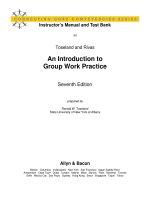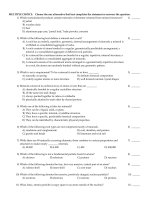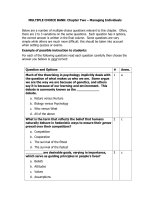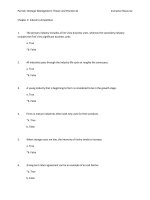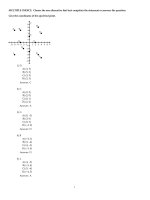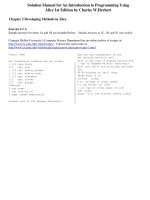Managing and organizations an introduction to theory and practice 4th edition by clegg kornberger pitsis test bank
Bạn đang xem bản rút gọn của tài liệu. Xem và tải ngay bản đầy đủ của tài liệu tại đây (380.6 KB, 12 trang )
Managing and Organizations: An Introduction to Theory and Practice 4th
edition by Stewart R. Clegg, Martin Kornberger, Tyrone S. Pitsis Test Bank
Link full download test bank: />
Chapter 2: Managing Sensemaking
MULTIPLE CHOICE BANK
Below are a number of multiple-choice questions relevant to this chapter. There are 2
to 3 variations on the same questions. Each question has 4 options, the correct answer
is starred. Some questions are very simple while others are much more difficult: this
should be taken into account when setting quizzes or exams.
Example of possible instruction to students:
For each of the following questions read each question carefully then choose the
answer you believe is most correct:
1. Which of the following defines sensemaking?
*a. The ongoing retrospective development of plausible images that rationalize what
people are doing
b.
How things are done, or are expected to be done, in particular organizations
c.
Ensuring that everyone understands the same thing in exactly the same way
d.
All of the above
2. Why is theory important?
a.
Because universities teach it
*b.
It provides patterned, coherent knowledge, evidentially testable
c.
It aligns members’ behavior to the objective of the organization
d.
All of the above
3. What are management practices?
a.
Rehearsals
b.
Something doctors have
*c.
What managers do when they are managing in everyday organizational life
d.
Illegitimate and non-sanctioned activities
4. The Introduction to your textbook discusses stakeholders. Which one of the following would
be the best definition of stakeholders?
*a.
People who have an interest in the organization
b.
People who own shares in a company
c.
People who picket a company
d.
All of the above
5. Who said ‘man is born free but everywhere he is in chains’?
a.
Karl Marx
b.
Groucho Marx
*c.
Jean-Jacques Rousseau
d.
Germaine Greer
6. Which of the following organizations tracks your whole life course?
a.
School
b.
The Electoral Office
c.
University
*d.
Registry of Births, Marriages and Deaths
7. Managing individuals in organizations is a task made difficult by the fact that everyone is
____________?
a.
Similar
b.
An employee
*c.Different
d.
Difficult
8. Organizations help to shape the ____________ of the persons working within
them. *a. Identity
b.
Spending patterns
c.
Consumption patterns
d.
All of the above
9. Which of the following would be thought of as a typical entrepreneur?
a.
George W. Bush
b.
Homer Simpson
c.
Kofi Annan
*d.
Richard Branson
10. What do the French call someone who is a bold, venturing, businessperson?
a.
A buccaneer
b.
An auteur
c.
A muse
*d.
An entrepreneur
11. Do entrepreneurs mean the end of bureaucratic organization and the rise of
creative individuals?
a.
Yes, entrepreneurs get rid of bureaucracy
b.
No, entrepreneurs love bureaucracy
c.
Yes, entrepreneurs manage through the projection of their incredible personal charisma
*d.
No, any successful business needs some form of bureaucracy
12. What does framing mean as identified in your textbook?
*a.
Focusing us on specific relevancies to sort what is relevant
b.
Putting pictures of an organization’s members on the walls
c.
Blaming someone up for something they didn’t do
d.
Learning the right theories from the textbook and applying them in practice
13. What does managing mean?
a.
Coping, getting by, just about staying afloat
*b. An active, relational practice which involves doing things to contribute to the
achievement of the organization’s formal goals
c.
Applying formal management models in action
d.
None of the above
14. What are organizations?
a.
Buildings that we work in
b.
Places in which people have lunch
*c. Systematically arranged frameworks relating people, things, knowledge, and
technologies, in a design intended to achieve specific goals
d.
Systematically arranged technologies intended to achieve specific goals if people do as
they are instructed or told
15. Management is defined in the Introduction as ________?
*a. The process of communicating, coordinating, and accomplishing action in the pursuit of
organizational objectives while managing relationships with stakeholders, technologies, and
other artifacts, both within as well as between organizations
b.
Giving orders to other people to do things
c.
The science of designing relationships between people so that the most efficient
people are in charge of things and the others are directed in what they do, according to plan
d.
None of the above
16. An institution is _______________?
a.
A place where mad, bad and damaged people are confined
b.
An illegitimate sub-culture
*c.
A recurrent patterned form of activity that fulfils basic functions for a society
d.
Defined by acts of parliament that allow one to do certain things
17. What does it mean to say that something exerts agency, according to the Introduction to
your textbook?
a.
Things go according to plan
*b.
It makes a difference
c.
Being managed
d.
All of the above
18. Organizations can be defined as ______ designed for a specific purpose
a.
Hands
*b.
Tools
c.
Brains
d.
Bodies
19. Something is rational, according to the Introduction to your textbook, ___________?
a.
Only when it is done according to scientific method
b.
goal
Only when there is systematic application of best practice to achieve some given end or
*c. Only when there is systematic application of various techniques to achieve some given
end or goal
d.
Only when something is done on the bosses terms only
20. Rationality is present when ____________?
a.
Things work out as intended by managerial plans
b.
Management’s ideas are perfectly implemented
c.
People do only what the rules say
*d. Things are done according to some way of making sense which might not be that of
management
21. Which of the following are characteristics of organizations?
a.
Purposes, objectives, and goals
b.
Structure, culture, communication processes, and human resource practices
c.
Systematic ordering in a hierarchy of actions
*d.
All of the above
22. Why is sensemaking a bit like driving?
a.
It involves a vehicle
b.
You have to stop and go a lot
*c.
It involves steering, and interpreting the actions of others
d.
All of the above
23. McDonalds can be seen as similar to some Universities because ________?
a.
Young people eat there
b.
They are well-lit with clean toilets
c.
Both have lots of queues
*d.
Both have lots of rules and prescribed offerings
24. All organizations have __________?
*a. Rules
b.
Parking lots
c.
Uniforms
d.
Shareholders
25. ___________________ usually means that organizations are assumed to have clear
boundaries, a large degree of autonomy, and distinctive characteristics that differentiate them
from other organizations?
a.
Organizational authority
b.
Organizational fragmentation
c.
Organizational dysfunction
*d. Organizational identity
26. Which one of the following would be typical characteristics of organizational hierarchy?
a.
Decentralization, differentiation and deceit
*b.
Communication, coordination and control
c.
Energy, efficiency and effervescence
d.
All of the above
27. The top management team can be defined as _______________?
a.
Those who are the best-remunerated in the organization
b.
Those who are the brightest in the organization
*c.
Those who set strategy, direction and purpose in the organization
d.
The best-dressed people in the organization
28. To say that sensemaking is retrospective means ____________?
*a. We make sense of something as it is elapsing and we are constantly reviewing the sense we
make in terms of additional sense-data
b.
We don’t know what we do until someone else makes sense for us
c.
Most of the time we act irrationally but we try to make sense of it by pretending
that we are being rational
d.
All of the above
29. Why is plausibility an important part of sensemaking??
a.
true
Managers have to persuade people that what is false is true and that what is false is
*b.
Managers have to create meaning that is sufficient to carry on with current projects
c.
Managers are normally deceitful as part of their job
d.
All of the above
30. What are unions from the manager’s point of view?
a.
A pest
b.
Oppositional bodies
c.
Disloyal organizations
*d.
Representative organizations
31. Which one of the following does NOT characterize managerialism?
*a. Managing with the assumption that managers’ interests should never override those of
customers and employees
b.
Normative integration, shared values, a single source of authority, legitimacy and
decision-making embedded in the managerial hierarchy, serving the interests of the owners of
that organization
c.
What managers practice when they have a profound grasp of management theory and its
principles and apply them consistently to all elements of their everyday organizational life
d.
A belief in the scientific application of management theory for best practice
32. If you were to say that an organization is like a well-oiled machine, which of the
following terms would characterize the comparison?
a.
Simile
b.
Rhetoric
*c.Metaphor
d.
Sensemaking
34. Who is the earliest acknowledged theorist of the importance of the division of labor
in management ______________?
a.
Karl Marx
b.
F. W. Taylor
c.
Emile Durkheim
*d. Adam Smith
35. According to the text book, why are highly rationalist accounts of management
popular with many managers?
a.
They are scientific
b.
Evidence backs them up
c.
Because of their opportunities for multiple sensemaking
*d.
They frame managers as being in control
36. Resistance can occur through both of which of the following pairs of terms ___________?
*a. Commission or omission
b.
Submission or fatalism
c.
Fatigue or fascination
d.
Obedience or compliance
37. What is a paradigm?
a.
A pyramid
b.
Something in Egypt
*c.
A model
d.
A unit of currency
38. According to your textbook, why might viewing organizations in terms of metaphors that
compare them to a giant organism be problematic?
a.
Because like human bodies organisms grow old and die
b.
Because it trivializes workers as appendages to a body
c.
Because it assumes management is the brain that controls everything on the body
*d.
Both b and c
39. Everyday business words like ‘headquarters’, ‘heads of department’ reflect the image of
organizations as ___________.
*a.
Hierarchies
b.
Superior
c.
Designed
d.
Barber shops
40. In organization studies, to refer to organizations as organs, machines, and the like is to use
____________.
*a.
A metaphor
b.
A sensemaker
c.
A tautology
d.
None of the above
41. The idea that people are cognitively limited, producing satisfactory rather than optimally
rational decisions through satisficing is known as _____________.
a.
Appeasement
b.
Delimited Rationality
*c. Bounded Rationality
d.
Grounding
SHORT ANSWER QUESTIONS
The section lists short answer questions with an outline of what might be expected in
a model answer. Students often will ask ‘how long should the answer be?’ Typically
answers should be around a page in length.
1. Why is sensemaking the crucial skill for managing organizations?
A satisfactory answer would note the important role of judgemental work by the
manager, their constant active agency in making sense of a complex environment of
artifacts, signs and things, and the constant need to monitor, reflexively, the world as
expected in management models and the world as constituted by the managers and
significant others sensemaking. A better answer would relate the specificities of
sensemaking to the changing environment in which contemporary sense is being made
– the material in the latter half of the chapter.
2. What are the essentials of sensemaking?
A satisfactory answer would provide a rudimentary gloss on the definition of
sensemaking given by Weick; a more sophisticated answer would do this and
provide key examples.
3. According to Brunsson (2006) why is the ‘implementation gap’ a good thing?
A satisfactory answer would note that it creates space in which others views might be
heard and acted on; a better answer would note that it functions as a reality check
against managerial fantasies – those in which the managers come to believe in the
omnipotence of their judgements and the correctness of their actions.
4. Compare and contrast driving and sensemaking
This is fairly straightforward: a satisfactory answer understands the similarities; a
more elaborated answer would recognize that the driver has far more control than the
manager and far more contingencies to deal with. An outstanding answer would
address some of the sensemaking locales of these, such as unions and industrial
relations systems
5. What is rationality and why is it so influential as a concept?
A satisfactory answer would define rationality and outline its assumptions; a more
sophisticated answer would note the metaphorical nature of these conceptions of
rationality and elaborate some of the common metaphors as developed in the
Introduction to the textbook, and address why certain conceptions of rationality – that
are highly rationalistic – should be so influential.
ESSAY QUESTION
The section is comprised of three (3) essay questions. The answers should reflect the
students’ knowledge of the topic area learned in class, their readings, and through other
sources. The good student will demonstrate their ability to reflect upon, and critique,
key ideas or issues. These questions can be incorporated into a mid-term or end of
semester exam. Conversely the questions can be assigned as a take-home essay
assignment. The length of the expected answer will vary accordingly, but typically
expect two to three pages in an exam setting, and request 2,000 words or more in a
take home essay assignment.
‘Managing is an exercise that strives to create rationality in order to make common
sense in organizations.’ Discuss and critically evaluate what you think are the key
tensions and issues that such a view of management illuminates.
Model answer
A model answer would include:
•
Definitions of managing, organizations and sensemaking
•
Reference to organizational rationality that encompasses discussion of both the
division of labour and the bounded rationality – sometimes contested – to which this
can give rise
•
Detailed discussion of the ways in which sensemaking can act to create
multiple, sometimes conflicting rationalities
•
A realization that managing always takes place in an organizational world subject
to many changing contextual factors and a discussion of what are taken to be the most
important of these, and justification for why they are important
•
A clear statement that the task of managing is to manage these conflicting
rationalities in the overall interests of the organization, and that this entails a subtle
balance of political, technical and creative skills
What are the contemporary factors shaping the sensemaking of managing
in contemporary organizations?
Model answer
A model answer would address how the following have an impact on managing
and organizations:
•
Organizations and technological changes
•
Changing relations of service and production
•
The implications of going global
•
Changing conceptions of time and space
•
Changing demographics; changing values
‘Managing will rarely if ever correspond with the management presumed in rational
plans and principles.’ Why should this be the case, according to the textbook?
Model answer
A model answer would address:
•
how managing is the art of sensemaking and that these plans and principles are
just one aspect of the ways in which sense gets to be made but that these do not
guarantee the sense that is made
INTEGRATED ESSAY QUESTION
This section is comprised of one (1) integrated question which requires the student to
demonstrate their reading and understanding of this chapter and an ability to
incorporate elements from other sections of this text book. Ideally this question is
best administered as a major take home assignment. The minimum length would be
3,000 words.
‘Life must be understood backwards; but... it must be lived forward.’ What
cautions should the well-educated manager take from Kierkegaard’s statement?
In your answer think about the concept of sensemaking, rationality and the role
of organizations and management in society.
